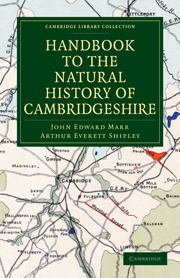Book contents
- Frontmatter
- PREFACE
- Contents
- ADDENDA AND CORRIGENDA
- PHYSIOGRAPHY
- GEOLOGY
- VERTEBRATE PALÆONTOLOGY
- ZOOLOGY
- Mammals
- Birds
- Reptiles and Amphibians
- Fishes
- Mollusca
- Insects: Introduction
- Insects: Orthoptera
- Insects: Neuroptera
- Insects: Hemiptera
- Insects: Coleoptera
- Insects: Lepidoptera
- Insects: Diptera
- Insects: Hymenoptera
- Myriapoda
- Arachnida
- Crustacea
- FLORA
- PREHISTORIC ARCHÆOLOGY
- Appendix to the Article on the Mollusca
- INDEX
- Plate section
FLORA
Published online by Cambridge University Press: 10 November 2010
- Frontmatter
- PREFACE
- Contents
- ADDENDA AND CORRIGENDA
- PHYSIOGRAPHY
- GEOLOGY
- VERTEBRATE PALÆONTOLOGY
- ZOOLOGY
- Mammals
- Birds
- Reptiles and Amphibians
- Fishes
- Mollusca
- Insects: Introduction
- Insects: Orthoptera
- Insects: Neuroptera
- Insects: Hemiptera
- Insects: Coleoptera
- Insects: Lepidoptera
- Insects: Diptera
- Insects: Hymenoptera
- Myriapoda
- Arachnida
- Crustacea
- FLORA
- PREHISTORIC ARCHÆOLOGY
- Appendix to the Article on the Mollusca
- INDEX
- Plate section
Summary
The object of this short account of the Flora of the Cambridge district is not to give a list of localities, but rather to direct the attention of the reader to the vegetation as a whole. In the first portion of the paper will be found a short analysis of our flora and an attempt to explain the present distribution, that is, the Cambridge flora in relation to that of the rest of England.
The remainder of the paper is occupied with an account of the plant associations found in the district or the local flora.
By the Cambridge district is meant that portion of the county which is within easy reach of the town either by train or bicycle–that is to say, it consists of the whole of South Cambridgeshire, a small strip of North Hertfordshire, a corner of Essex and the western border of Suffolk.
Watson classified British plants according to their distribution in the Island. Those that were generally distributed he called British, those that were abundant in the south and tended to disappear towards the north he called English. He found that there were certain plants restricted to the East of England, to which he gave the name Germanic, not thereby implying that they had their origin in Germany, but using the word simply as a name to signify that they were plants found on that side of England which bordered on the German Ocean.
- Type
- Chapter
- Information
- Handbook to the Natural History of Cambridgeshire , pp. 209 - 237Publisher: Cambridge University PressPrint publication year: 2010First published in: 1904

